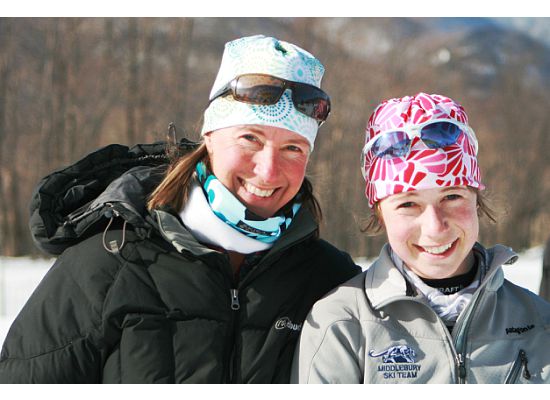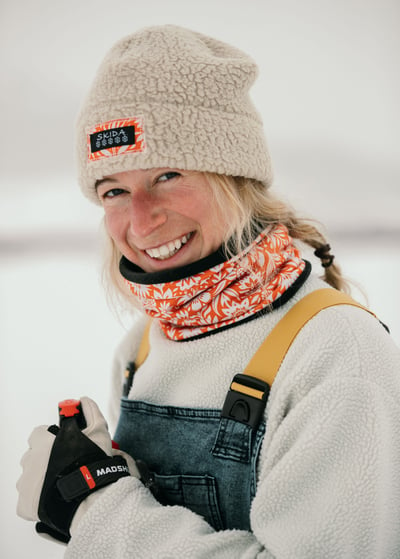Walk into any coffee shop in Vermont or visit any ski hill, and you’ll see heads covered in patterns of brightly colored flowers, butterflies, or tiny foxes, paired with neck warmers clad in similarly cheerful patterns pulled up over chilled rosy cheeks. In 2008, when Corinne Prevot, a crafty high schooler, started making hats for herself and her ski teammates, this explosion of colored patterns on slopes and in towns began. Sixteen years later, Prevot is now the founder behind the growing, beloved Vermont brand Skida. Many things have changed since her first hats, but the delightful patterns remain her signature.
Surprisingly, Prevot didn’t formally study textiles or product design. Her mom, Margie, taught her to sew. Growing up, Prevot and her mom crafted their own design team and textile homeschool using family and friends to product-test handmade fleece pants, long underwear, wallets, and eventually, hats. Of all their projects, nothing took off as a business idea until Prevot made cross-country ski hats while a Nordic skier in high school at Burke Mountain Academy. That's how it all began. Marketing doesn’t get much more grassroots than traveling to ski races with extra handmade hats to sell.
 Margie and Corinne at a ski race, 2010
Margie and Corinne at a ski race, 2010
In 2011, while a sociology and anthropology major at Middlebury College, Prevot studied abroad in Nepal for four months. Studying in Nepal gave her life direction and opened her eyes to a new and different culture in another part of the world. She discovered the cashmere industry during her studies and later returned to the same factories after starting Skida. Prevot has worked with those factories in Nepal for over 10 years now and 100% of Skida’s cashmere comes from them.
We learned that barely a scrap of fabric goes unused in Skida’s production process. Less waste, less harm. Also, Skida uses recycled materials whenever possible. Its fleece-lined Alpine line, for example, uses microfleece made from 87% recycled materials. Apart from its cashmere, 100% of the brand’s original product line, its Vermont Collection, is made in Vermont.
We recently had the opportunity to catch up with Prevot. Here's what we learned about how this little, now big, homegrown brand has thrived:
KSV: What are some of the most successful marketing strategies Skida has employed to get the brand to where it is today?
Prevot: Riding the wave of the pandemic over the last five years has presented a lot of different strategies, just as digital marketing has evolved. We got our start from an organic community momentum within the ski space. I was going around to ski races with my hats and we'd hang them on clotheslines. That was a beautiful, organic phase of the brand.
KSV: Apart from the collaborations with pro athletes, do you seek out partner brands, or do they come to you?
Prevot: Both, it’s mixed: Some brands we pursue, and others reach out to us. Overall, our collaborations have been a successful marketing strategy. They allow us to partner with brands and organizations with messages and missions we believe in. This allows us to amplify the work of these organizations while also diversifying the designs and messages that we're sharing. It's been a beautiful evolution over the years.
KSV: From an outside perspective, your partnerships look organic and seamless.
Prevot: So much is related to personal relationships. It takes just one person to see the connection and synergy and say, "Oh, we can do this," or "Wouldn't it be great if we could combine our messaging?” And then the whole team makes it happen.
Another marketing mechanism is our network of wholesale retailers across the country. We leaned into experimental pop-up shops. This past year, in Q4, we opened a pop-up store on Pearl Street in Boulder, Colorado. Over three months, we held several events at the shop and had a team managing the store and integrating with the community. It was a blast.
KSV: You've accomplished so much through grassroots marketing and word of mouth, correct?
Prevot: Yes, that's been huge. In 2008, I ran a blog for three years when I started making hats. In 2010/2011, I launched my first e-commerce site. I built a website with images of prints only using regular HTML coding. People could fill out and submit an order form through the site for the product style and print they wanted. Then, the customer would send me a check in the mail. This was before we had tech payment processing or online digital payment processing. I'd receive the check, mail the hat and the order, and voilà! That was 12 or 13 years ago.
KSV: When you made your first batch of hats for ski teammates in the 2000s and created Skida, did you ever see the company growing as big as it has?
Prevot: I set up shop in Burlington thinking, "All right, cool. I'm going to do this for a few years and see what happens." It's grown beyond my wildest dreams.
KSV: Are there any barriers Skida faced in developing the brand and staying competitive as the market grew and evolved?
Prevot: The biggest barrier that we've had is just continuing. We had to rally to overcome the challenges of the pandemic. We’re an organically grown business that's been funded by its working capital — we don't have outside investment. All of our growth initiatives, strategic growth, marketing strategies, and everything is self-funded.
This approach forces us to be grassroots, grow organically, and be responsible for our growth. You could also see that as a barrier, where we have yet to spend an excessive amount of money any particular year to turbocharge the business. But I'm happy with that because it's been manageable, and our team's been able to grow.
KSV: How does Skida balance eco-consciousness and sustainability with profit and revenue growth?
Prevot: We practice financial sustainability by growing from our working capital, rolling our profits into the business the next year, building inventory, supporting our staff, and growing our headcount.
In terms of our eco-consciousness, we've focused on zero waste. That's been our big M.O. All our products, except our cashmere, are currently manufactured in the US. Domestic manufacturing has been a big focus. About 80% of our product line is made in Vermont alone. Our local supply chain is an important sustainability element.
 Corinne in the Skida office, 2016
Corinne in the Skida office, 2016
KSV: What strategies does Skida employ to help make customers feel seen, heard, and included?
Prevot: We've been focused on representation through our different campaigns — that's been important. We have awesome customers who contribute to the social media platforms of how they're using our product. We use UGC — user-generated content — to show what our authentic community is doing, how they're using the product, and how they're getting outside and staying healthy and active. Then we do a survey every couple of years to hear directly from our customers and community.
KSV: How has Skida viewed the development of technology in enabling the advancement of how it can serve customers?
Prevot: Technology development is fun because of our early journey from blog to website to e-commerce platform. Many interesting tech companies have come up over the last 10 years that can support what we do for customer service, how we get orders shipped out, and the visibility we have on our supply chains.
There are so many more tools now, and it's only getting better. I'm curious to see what AI does even on the graphic design side. We work with Adobe and we work with Figma. We're able to collaborate now across multiple team members, in different remote locations, on the same design files all at once. That's insane.
It's made marketing campaign creation fun and creative, and it's allowed our storytelling to take on different forms. We're able to tell more stories and bring in more design elements to make them richer, more colorful, and more interesting.
KSV: What are some things you’re most proud of accomplishing at Skida?
Prevot: I feel proud of the brand ethos and personality that it's taken on internationally. The head of marketing and sales of a heli-skiing operation out of Revelstoke, British Columbia, recently wrote that Skida has become a conversation catalyst. Like “a charming secret handshake,” their US-based guests always express admiration and excitement when they see that Revelstoke carries Skida.
The other thing that I'm proud of is Skida’s intergenerational appeal — our customer base is of all ages. I'm proud of that. It’s unique.
KSV: What advice would you give to your less experienced self?
Prevot: It can all work out. It's not pretty all the time, sometimes it feels like you'll go through patches where things feel disorganized, or the structure may not be what you want it to be, or you're not hitting the marks that you want to hit at a certain time. That's okay. It's a long game. Everybody has a different impression of your brand, business, and your product.
I'm grateful that I didn't know what I didn't know at that young age. I went to my first national trade show so blind. We pulled off a massive amount of work and a huge operation getting a booth out there.
My first booth was built out of reclaimed barn wood from Vermont that we freight-palleted out to Denver and got ourselves on the main floor next to all the big brands I've admired in the ski and outdoor space. Looking back, if I needed to pull off now what we pulled off then — I don't think I would try. Now I understand the undertaking.
 Corinne in Aspen, 2021
Corinne in Aspen, 2021
KSV: What would you like to pass on to the next generation of female entrepreneurs and founders in any industry?
Prevot: Start small and try new things. We're entering our 16th year of the brand. It can be easy to get caught up in instant gratification, but things take a lot of time to build. Founders and entrepreneurs need to allow themselves time for their products and ideas to gain momentum and traction and to try new things. If something's not working, phase it out and try something new.
Everyone will have their journey in how they discover your brand and experience your product. You might set out trying to put something out there for it to look and feel a certain way, and someone might interpret it differently. That’s the beautiful thing about designing products: It’s the storytelling component and letting people have different interpretations.
We’re grateful to Corinne for sharing her story with us. Find more information about Skida here, and catch more of KSV’s Industry Expert interviews here.
